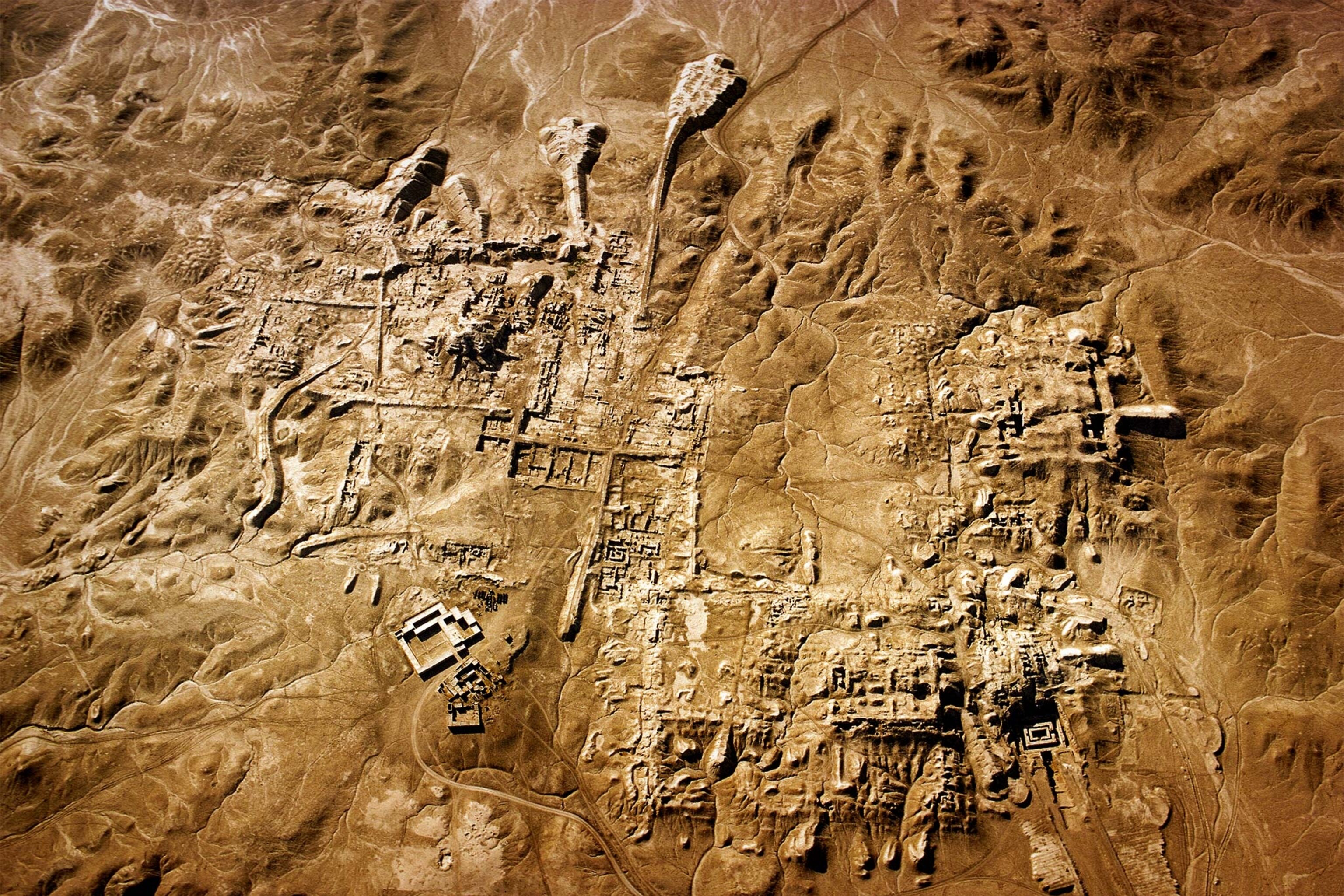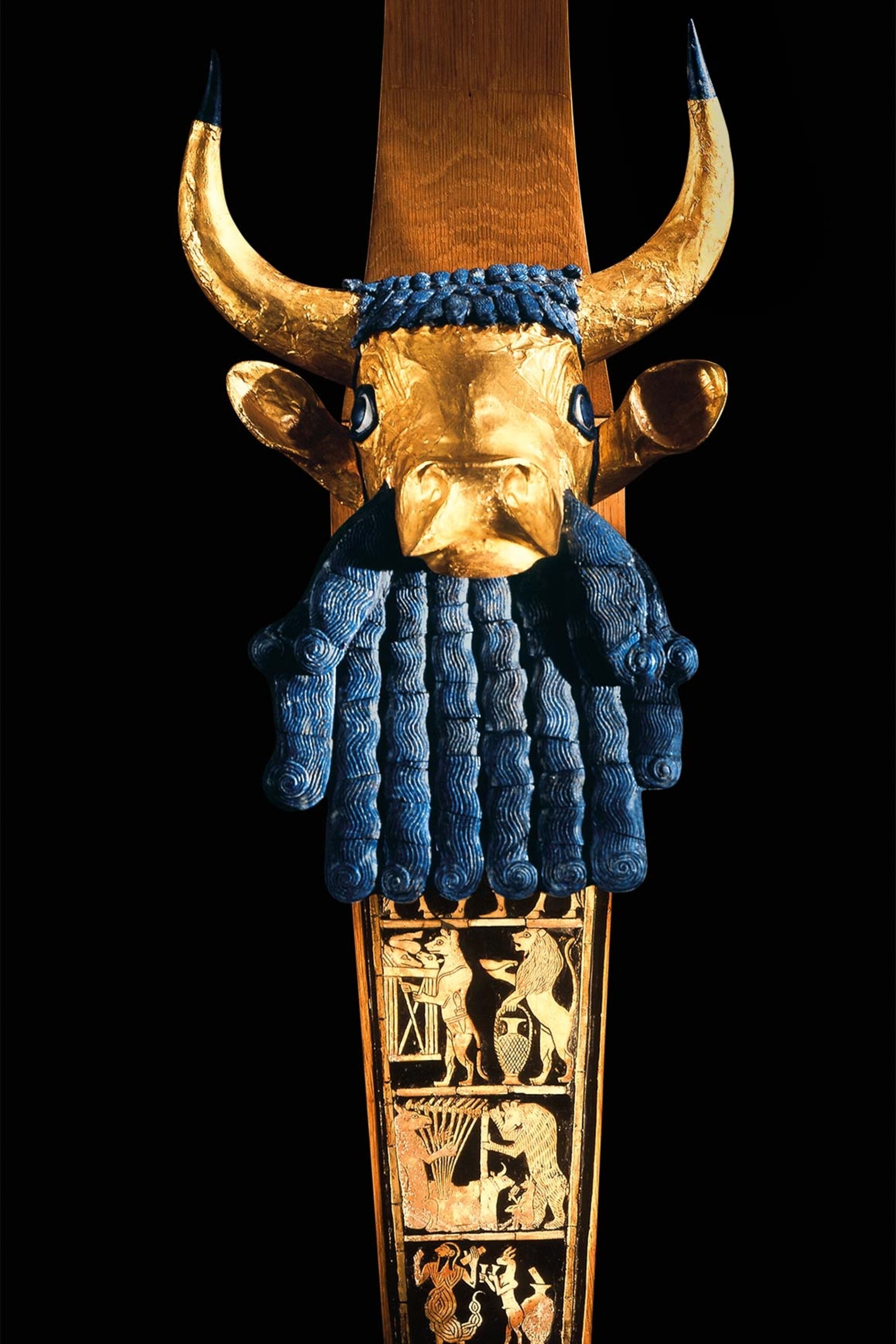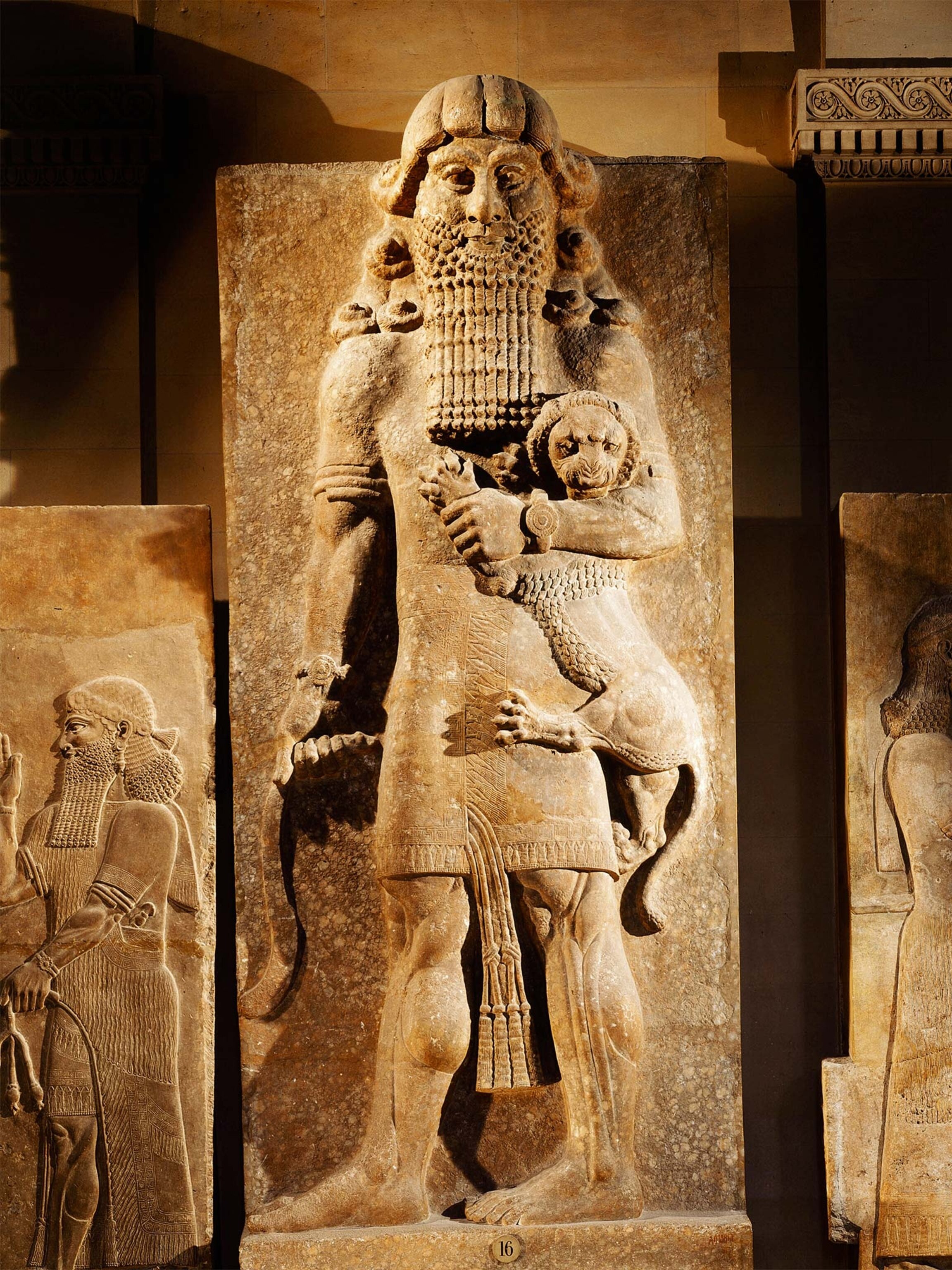
This ancient society helped build the modern world.
Writing, laws, cities, and science—these and other innovations were devised by the enterprising peoples living in Sumer, the land between the Tigris and Euphrates rivers, some 5,000 years ago.
The foundations of human civilization first flowered in the fertile lands between the Euphrates and Tigris Rivers. Known today as Sumer, this ground-breaking culture gave birth to not only the first cities but also innovations in transportation, literature, and monumental architecture.
For more than 2,000 years, Sumerian culture flourished and was the dominant power in Mesopotamia. Across the region that is now southern Iraq, powerful city-states emerged, towering ziggurats rose, sweeping epics were told, and golden jewelry adorned the rich and powerful. Dominance and control would shift among its glorious cities as the years rolled by. The civilization reached its peak in the late third millennium B.C and then gradually fell away. Sumerian civilization and its achievements would be forgotten for millennia, until archaeologists began exploring the region in earnest in the 19th and 20th centuries. Glorious finds in the area revealed the richness and complexity of this ancient culture and allowed scholars to see how Sumerian influences cascaded through the civilizations that followed it.
(They were scouting for oil in Iran. They found an ancient temple instead.)
Cities and kings
Settlers arrived in the Mesopotamian floodplain around the sixth millennium B.C. These innovators devised an irrigation system of canals to harness the waters of the Tigris and Euphrates and better manage agriculture in the region. Their success created rich agricultural centers of trade. The wealth turned settlements into villages, and villages grew into cities with thousands of residents.
By 3500 B.C., Sumer had grown into a collection of city-states linked by linguistic and religious traditions. Among the most significant were Eridu, Uruk, Ur, Larsa, Isin, Adab, Lagash, Nippur, and Kish. Over time, some of them grew more powerful than others, and for brief periods, one city-state might rule the others until it fell from power. The Bible mentions Sumerian cities and rulers: “The beginning of his kingdom was Babel, Erech, and Accad, all of them in the land of Shinar. From that land he went into Assyria, and built Nineveh, Rehobothir, Calah,and Resen between Nineveh and Calah; that is the great city” (Genesis 10:10-12).
(Why this ancient 'King of the World' in Assyria was so proud of his library.)


These cities were ruled by kings, whose names might have been forgotten were it not for the discovery of the Sumerian King List. Copies of the list have been found on 16 different clay tablets or cylinders found across Mesopotamia. The most complete one features the names of prominent cities, their rulers, and how long they ruled. Scholars are quick to point out that the Sumerian King List blends legend and history, with the earliest kings enjoying excessively long reigns and the more recent having human-size lengths of time on the throne.
Rise of Uruk
The very first city-state to rise to prominence was Uruk (called “Erech” in the Bible). According to the Sumerian King List, it was founded by King Enmerkar around 4500 B.C. At its peak, Uruk numbered some 40,000 inhabitants—a huge population that drove significant economic development.
(Age-old secrets revealed from the world's first metropolises: including Uruk.)

The city’s wealth was reflected in its monumental architecture. Uruk’s ziggurat, dedicated to the Sumerian sky god Anu, was completed by the late fourth millennium B.C. Topped with its White Temple, its soaring form, resplendent in sunshine, would have soared high many centuries before Egypt’s Great Pyramid.
Excavations in the 20th century by German archaeologists revealed Uruk’s richness, with evidence of large-scale gold-, silver-, and copper-working. Other massive structures were uncovered, including smaller brick temples and a defensive wall. Archaeologists recovered troves of clay tablets as well as works of art.

Scholars continued to piece together Sumerian history as other cities were excavated. In Lagash, a sophisticated irrigation and sluice system was found. The most famous discoveries were found by the British Museum’s Leonard Woolley and the University of Pennsylvania. They uncovered Ur, a city that peaked in the late third millennium B.C. Woolley’s digs of the 1920s and ’30s excavated Ur’s 80-foot-tall ziggurat dedicated to the moon god Nanna.
Woolley also discovered the city’s royal cemetery from the mid-third millennium B.C. These tombs held crowns, necklaces, and the exquisite box known as the Standard of Ur, inlaid with jeweled mosaics depicting scenes of war and booty. The tombs also contain the remains of royal servants sacrificed to continue “serving” their sovereigns beyond the grave.
(The royal tombs of Ur revealed Mesopotamia's golden splendor.)





Birth of writing
Sumer’s gifts to humanity are immeasurable. The word “Sumer” comes from shumerum, which was what the Akkadians, Sumer’s neighbors to the north, called the inhabitants of this area. The ancient Sumerians called themselves salmat qaqqadi, meaning “black heads.”
Sumer’s agricultural successes led to a need for a methodical system of recording information. Sumerian merchants needed reliable ways to track their businesses. Somewhere around 3500 B.C., merchants began using soft clay tablets impressed with small symbols to keep track of their goods. These pictorial symbols evolved by 3200 B.C. into a complex series of signs of about 600 characters known as Sumerian script. Writing had been born.


Resembling little wedges and lines, Sumerian writing was created by pressing a reed into wet clay tablets. This technique gave the system its modern name of cuneiform, from the Latin word for wedge. Sumerian script sparked a revolution. Other language groups found across Mesopotamia adopted it. Cuneiform tablets have been found in multiple Sumerian archaeological sites.
(Buried for 4,000 years, this ancient culture could expand the 'Cradle of Civilization'.)
Commerce was one way cuneiform spread, but scholars believe that conquest was another. Sumerian cities conquering each other expedited cultural exchanges. For instance, Eannatum of Lagash brought not only much of Sumer under his control in around 2500 B.C. but also areas of Elam to the east. Ironically, however, the durability of Sumerian literary culture and the use of the cuneiform system—which later spread throughout the Near East and remained in use until as late as A.D. 75—owes less to Sumer conquering than its being conquered.

Language and literature
In 2330 B.C., Sargon of Akkad (identified by some scholars as Nimrod in the Old Testament) toppled Lugalzagesi of Uruk, Sumer’s dominant ruler at the time. Uniting Akkad with Sumer as part of his conquest of Mesopotamia, Sargon forged history’s first multinational empire.
(Meet the world’s first emperor.)
During the Akkadian control of Sumer, Akkadian was the preferred language but it was written in Sumerian cuneiform. This choice helped preserve Sumerian literary texts. Many of them were preserved in copies from the later Old Babylonian period (2003-1595 B.C.). Sumerian literature included hymns, magic spells, morality texts, and myths about the gods.
Early poems in Sumerian about a king of Uruk called Gilgamesh were later woven into an epic tale, a version of which was found in Nineveh in the 19th century. Gilgamesh’s quest for immortality has entered the canon of classic literature and been translated into numerous languages across the world. It is hailed as one of the world’s earliest heroic epics.
(Discovering Gilgamesh, the world’s first action hero.)
Fantasy and reality

The Sumerians’ rich written record also preserved evidence of medical advances , including the first prescriptions in history. These texts include a description of the ailment and a suggested remedy. References to poultices, potions, and dousing appear in Sumerian texts. Although it has been difficult to identify the ailments with any known conditions, these records suggest that Sumerian pharmacology was advanced. They show knowledge of sophisticated methods for obtaining substances such as powdered alkali, potassium nitrate, and saltpeter for use in their remedies.

Law and order
Following the fall of the Akkadian Empire around 2150 B.C., Sumer was overrun by a people from the eastern highlands known as the Gutians. Sumerian kings regained control around the 21st century B.C., in a period historians call the Third Dynasty of Ur. Its founder, Ur-Nammu, was a great general, reformer, and innovator. He is credited with building the great Ziggurat of Ur, but perhaps his greatest achievement was creating the world’s first legal code.

The reconstructed text, based on fragmentary copies found in the 20th century A.D.,begins with an account of how Ur-Nammu established justice, reforming the system of weights and measures and ensuring that orphans and widows were not prey to the powerful. Ur-Nammu’s code influenced later Mesopotamian legal systems, most notably the Code of Hammurabi, the Babylonian king who reigned three centuries later.
(History's first superpower sprang from ancient Iran.)
The revival of Sumerian power under the Third Dynasty of Ur was short-lived. Ur was conquered by the Elamites, who captured its last king around 2004 B.C. The city’s destruction was commemorated in the “Lament for Ur.” Similar Mesopotamian works have been discovered, and scholars liken the “Lament for Ur” to the Book of Lamentations in the Bible.
Divine and domesticated

The goddess Ningal weeps for her city in the lines of the stirring work, which scholars have pieced together from different cuneiform tablets:
Dead men, not potsherds, covered the approaches. The walls were gaping, the high gates, the roads, were piled with dead.
The Elamite sacking of Ur effectively ended Sumerian power, and the Sumerian language would soon be extinct. Sumeria’s mighty cities and its world-changing texts lay hidden until their triumphant reemergence nearly 4,000 years later. A lost civilization was found again—one that planted the seeds of human civilization itself.
You May Also Like
Go Further
Animals
- How can we protect grizzlies from their biggest threat—trains?How can we protect grizzlies from their biggest threat—trains?
- This ‘saber-toothed’ salmon wasn’t quite what we thoughtThis ‘saber-toothed’ salmon wasn’t quite what we thought
- Why this rhino-zebra friendship makes perfect senseWhy this rhino-zebra friendship makes perfect sense
- When did bioluminescence evolve? It’s older than we thought.When did bioluminescence evolve? It’s older than we thought.
- Soy, skim … spider. Are any of these technically milk?Soy, skim … spider. Are any of these technically milk?
Environment
- Are the Great Lakes the key to solving America’s emissions conundrum?Are the Great Lakes the key to solving America’s emissions conundrum?
- The world’s historic sites face climate change. Can Petra lead the way?The world’s historic sites face climate change. Can Petra lead the way?
- This pristine piece of the Amazon shows nature’s resilienceThis pristine piece of the Amazon shows nature’s resilience
- Listen to 30 years of climate change transformed into haunting musicListen to 30 years of climate change transformed into haunting music
History & Culture
- Meet the original members of the tortured poets departmentMeet the original members of the tortured poets department
- Séances at the White House? Why these first ladies turned to the occultSéances at the White House? Why these first ladies turned to the occult
- Gambling is everywhere now. When is that a problem?Gambling is everywhere now. When is that a problem?
- Beauty is pain—at least it was in 17th-century SpainBeauty is pain—at least it was in 17th-century Spain
Science
- Here's how astronomers found one of the rarest phenomenons in spaceHere's how astronomers found one of the rarest phenomenons in space
- Not an extrovert or introvert? There’s a word for that.Not an extrovert or introvert? There’s a word for that.
- NASA has a plan to clean up space junk—but is going green enough?NASA has a plan to clean up space junk—but is going green enough?
- Soy, skim … spider. Are any of these technically milk?Soy, skim … spider. Are any of these technically milk?
Travel
- Could Mexico's Chepe Express be the ultimate slow rail adventure?Could Mexico's Chepe Express be the ultimate slow rail adventure?
- What it's like to hike the Camino del Mayab in MexicoWhat it's like to hike the Camino del Mayab in Mexico







